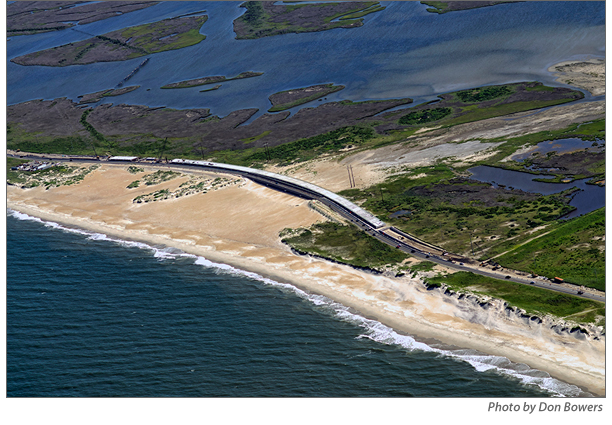Construction is steadily moving along on two of the three new bridges for Hatteras Island, and plans are in the works to have the new temporary bridge at the Pea Island Inlet completed by mid-October.
“The contractor [for the temporary inlet bridge] made some remarkable progress since this past winter, and we are hoping to begin the paving to tie the new bridge into the existing part of Highway 12 soon,” said Pablo A. Hernandez, the resident engineer for the North Carolina Department of Transportation (NCDOT) and the project manager for both ongoing bridge projects. “We’re targeting a mid-October timeframe for that bridge to be complete.”
For the temporary bridge at the site of the inlet cut by Hurricane Irene in 2011, there is one more span of core slabs that need to be set on the south end. In order to proceed, crews will need to get the roadway filled to a certain elevation, and then install the last pre-cast cap which is the piece that sets on top of the piling. Once that is done, the girders – or slabs – that will serve as the bridge deck can be set. “We are hoping that this will all take place by the end of the month,” says Hernandez.
A lot of the forward progress on the new temporary bridge is weather dependent.
“We’re hoping that all the parts and pieces will fall into place so that we can start paving by the second half of October,” says Hernandez. “Once we start the paving to tie in the new roadway to the existing Highway 12, we are committed because of the elevation difference, and the way the road is sloped.”
The actual bridge and new roadway is roughly one mile along, but with additional paving required to bring Highway 12 to its condition prior to 2014, the total area that will need to be paved is 2.5 miles. Once complete, the road adjacent to the temporary bridge will be wider with 12-foot lanes and 5-foot shoulders, like the rest of N.C. Highway 12.
Travelers should expect one-lane roads when the paving begins, with a pilot car directing traffic in the daytime, and a traffic signal at night. “It should be three days of paving if everything goes well when we’re making that actual tie-in,” says Hernandez.
The Bonner Bridge replacement is also progressing nicely, with three distinctive sites of activity – the north end of the bridge, the south end of the bridge, and the middle section on the open water. “The focus is on continuing to tackle the project in its three work fronts – if you drive through the project and cross the existing bridge, you can see we have three mini bridge projects going on at once,” says Hernandez.
Out in the center site, two and a half bridge spans, or cantilevers, have been completed with a road surface elevation of 90.4 feet. “Right now, it’s taking about a month per cantilever,” explains Hernandez. “We start at the actual column, and alternate adding pieces – a piece to the north side, a piece to the south side – so we end up with a big letter T which reaches out and touches another capital T.”
A total of 11 spans will be created using this technique.
On the south end of the Bonner Bridge, crews are working fairly deep below the surface of the ground, as evident by the big brown walls that have gone up that allow the team to work 6-8 ft. under the surface. This allows workers to build the footings that will tie all three bridge sections together in the coming year.
The third bridge that is part of the overall project – the North Rodanthe Bridge – is still in the design and permit application preparation phase. Construction on the third bridge is expected to start in the winter of 2018, which is contingent on getting permits by January or February of 2018.









